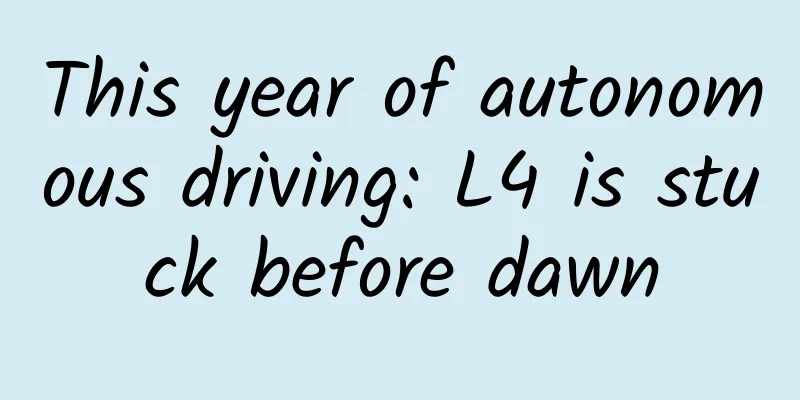This year of autonomous driving: L4 is stuck before dawn

|
Two flowers bloom, each showing its own beauty. Although both are autonomous driving, the stories told by L4 and L2 in 2023 are completely different. (The autonomous driving mentioned below refers specifically to fully autonomous driving at L4 and above) In fact, for L4 autonomous driving, the beginning of this year was full of hope, because the light emitted by ChatGPT also shone on autonomous driving. Then in August, California passed a bill for the first time, allowing Waymo and Cruise's Robotaxi to operate unrestricted in San Francisco. At that time, almost everyone thought that the moment the bill was enacted would mean the beginning of Robotaxi's commercial take-off; but now looking back, that moment should perhaps be described as the last straw that broke the camel's back for Robotaxi. Autonomous driving, the pain is because you are still alive The first to be affected is naturally Cruise. During operations in San Francisco, Cruise's Robotaxi ran into construction sites, got stuck in wet concrete, and stalled in the middle of the road, causing traffic jams until the most serious car accident killed a woman. ▲Cruise driving on the road Source: detroitnews.com Afterwards, this once top autonomous driving company had its driverless car operating license revoked due to safety issues, and the avalanche began. At the end of November, Cruise co-founder and CEO Kyle Vogt announced his resignation. Less than a day later, Cruise's other co-founder and Chief Product Officer (CPO) Daniel Kan also left the company. Then, there was news that GM would drastically cut Cruise's budget and layoffs. On December 15, Cruise officially announced that it would lay off 900 employees, accounting for about 24% of the total employees. Cruise’s collapse is just the most typical footnote to autonomous driving in this era, because on a larger scale, the collapse of autonomous driving continues. In China, Baidu's autonomous driving business changed its leadership in early November. Wang Yunpeng, who was previously in charge of the Robotaxi business, replaced Li Zhenyu and took full responsibility for the business of Baidu's Intelligent Driving Business Group (Baidu IDG). This is also the first change of leadership at Baidu's autonomous driving business in six years. Earlier in May, the CEO of Qiangua Technology, which focuses on autonomous driving for trunk logistics, resigned and was replaced by the chairman; in June, WeRide COO Zhang Li resigned and switched to the legged robot track to start a new business; in August, Wu Xinzhou, vice president of Xiaopeng Motors' autonomous driving center, resigned and joined chip giant Nvidia... The top-level power structures of many autonomous driving companies have begun to change frequently. At the same time, many autonomous driving companies and projects are on the brink of life and death and may collapse overnight. In China, Alibaba DAMO Academy officially announced in May that it would abandon the development of autonomous driving and transfer all its teams to Cainiao. In July, Kingdee Intelligent Card, which focused on L4 autonomous driving trucks, was reported to have stopped production. Overseas, Embark, a star L4 driverless smart truck company with a market value of up to $5.2 billion, was acquired in May; Waymo shut down its driverless truck project in July after a massive layoff at the beginning of the year... ▲Embark unmanned truck, source: official website We will see that from personnel adjustments to corporate business shifts, autonomous driving in 2023 will continue to be a story of closures, shutdowns, layoffs and budget cuts, casting a huge shadow over the entire industry. Cruise is like the kid who always ranks at the top of the class. When the papers he hands in are terrible, it is not only a blow to himself, but also to everyone's confidence in the class as a whole. Just as He Xiaopeng mentioned on Weibo when commenting on the Cruise avalanche: High-level automatic assisted driving or manned fully autonomous driving can see a clear roadmap, but completely unmanned driving cannot see the complete logic. I even think that we may need to find another way. "Finding another way" is like a huge chasm standing in the way of all those who want to achieve the ultimate goal of fully autonomous driving. After all, if the technical path has not been paved, then the business model will be even more of a castle in the air. ▲ Screenshot of He Xiaopeng's Weibo It’s cold, just like Beijing’s winter, with strong winds mixed with biting ice and snow, wreaking havoc throughout the autonomous driving industry. The performance of the capital market also seems to respond to this sentiment. According to incomplete statistics from "Self-Quadrant" through public data, in the first three quarters of 2023, there were approximately 54 domestic autonomous driving financing projects, with a total disclosed financing amount of approximately 6.8 billion yuan. In comparison, in 2021, there were 144 investment and financing events in the domestic autonomous driving industry, with a financing scale of 93.2 billion yuan; in 2022, there were about 128 investment and financing events in the autonomous driving industry, with a financing scale of 24 billion yuan, which was only a quarter of that in 2021. By 2023, the total financing in the first three quarters was only a quarter of that in 2022. We will see that autonomous driving has indeed fallen to an unprecedented low point throughout 2023, but we will also see that behind the huge pressure, autonomous driving is not completely hopeless. In fact, what we have seen before is just a projection of this huge industry group. Because if we really look directly at this market with a size of over one trillion, we will find that the entire autonomous driving industry is actually undergoing a new transformation in great pain. For example, TuSimple, known as the first L4 autonomous truck stock, has begun to readjust its strategy after experiencing management turmoil, delisting warnings, and large-scale layoffs in the United States. It has shifted its focus back to China, and related lines will be implemented in Shanghai. For example, at the end of August, Xiaopeng Motors and Didi reached a cooperation. Xiaopeng acquired the assets and R&D capabilities related to Didi’s smart electric vehicle project by issuing additional shares. Xiaopeng thus inserted a nail in the robotaxi industry in advance. In addition, Didi and GAC Aion also signed a cooperation agreement in May, confirming that L4-level driverless taxis will be launched in 2025; and L4 truck company Embark Trucks was acquired by intelligent driving software developer Applied Intuition; in September, autonomous driving company Nullmax was acquired by Yanshan Technology; in November, Pony.ai's L4 truck was approved for road use in Guangzhou, and Huawei's car BU was determined to be independent and open for financing... ▲Didi autonomous driving image source official website We will find that although the entire autonomous driving industry has experienced turbulence, it is more like a systematic new resource allocation under the manipulation of the invisible hand of the market. Some companies focus on their core businesses, divest their weak projects and transfer them to companies with more advantages; some companies move from markets with worse ecological environments to markets with better environments; and some companies that retain their strength seize some valuable advantageous assets in advance, and so on. During this process, some people withdrew, but others continued to increase their investment. For example, Masayoshi Son of SoftBank invested US$1 billion in Stack AV, a new self-driving truck company spun out of Argo AI, in September this year. In August this year, WeRide's application for IPO in the United States was approved by the China Securities Regulatory Commission. In addition, there are rumors that many autonomous driving companies such as Momenta, ZongMu Technology, Zhixing Technology, and PlusAI Technology are also rushing for IPO. When the primary market cools down, listing financing becomes a rare way to solve historical capital problems and obtain new blood to prolong life, and this will also become an important bargaining chip for these companies to still fight hard today. So we feel that today in the field of autonomous driving, from entrepreneurs to investors, from start-ups to mature companies, every person and every company is trying hard to survive. Although everyone is experiencing difficulties, more are readjusting their postures, accumulating strength, and planning to fight again. To bloom in the mud In fact, there are still many new opportunities in autonomous driving. Since the beginning of this year, large AI models represented by ChatGPT have opened the door to AGI. As a result, autonomous driving is also facing the reconstruction of underlying technologies and the reengineering of development processes. The application of big models in autonomous driving is mainly reflected in two dimensions. The first is that big models are used as tools to assist in the training of autonomous driving algorithms. The second is that big models are used as decision-making models to control vehicle driving and improve the generalization ability of autonomous driving. The first is auxiliary algorithm training. In June of this year, Tesla mentioned the world model at the CVPR 2023 WAD Workshop. It can use a large amount of real-life video data collected by autonomous vehicles to generate future scenes through a generative model, and then cross-compare the generated data with the real data to construct a loss, thereby achieving training of the model without relying on labeled information. Specifically, the world model can be used as a simulation tool to generate simulation data on a large scale, especially for extremely rare corner cases. Based on the same principle, Haomo also launched a similar large model application at AI Day in October. Relying on DriveGPT released earlier this year, Haomo can match the cross-features of images and texts and then put them into the large language model for the search (query) features formed in the feature space. On this basis, the large model can re-label the stock data according to the scene requirements without much preparation. In October, Waymo and Google also released a new autonomous driving simulator, which can place multiple agents in the same simulation environment, constantly simulate real traffic conditions, and allow the autonomous driving system to better learn decision-making and planning, thereby shortening the overall training time. At about the same time, researchers from the Institute of Automation of the Chinese Academy of Sciences, the Institute of Artificial Intelligence (AIR) of Tsinghua University, Peking University and other institutions released an end-to-end algorithm called ADAPT (Action-aware Driving Caption Transformer), which is a Transformer-based driving behavior description framework that can perceive and predict driving behavior and output natural language narration and reasoning. This solves a major problem that plagues autonomous driving today, which is that we do not know how the autonomous driving algorithm ultimately makes a decision. ADAPT can help the autonomous driving algorithm explain to humans why it behaves in this way, thereby helping scientific researchers to more easily understand the operating logic of the autonomous driving algorithm. Secondly, the large model is used as a decision-making model in the control of autonomous driving vehicles. Representatively, Musk demonstrated Tesla's end-to-end control technology in August. Musk said that thanks to the application of "end-to-end" control technology, Tesla FSD V12 version has reduced hundreds of thousands of lines of code and can still work on unfamiliar terrain without a data connection. Therefore, although the big model has not brought about earth-shaking technological breakthroughs in autonomous driving like ChatGPT to this day, the big model has pointed out a new feasible path for the future realization of autonomous driving. In addition to new technological advances, what is more important for autonomous driving is to obtain the same right to drive on the road as ordinary cars, and this has been implemented this year. At the end of November, the Ministry of Industry and Information Technology, the Ministry of Transport and other four departments jointly issued the "Notice on the Pilot Work of Access and Road Use of Intelligent Connected Vehicles" (hereinafter referred to as the Notice); in early December, the Ministry of Transport issued the "Guidelines for Autonomous Driving Vehicle Transportation Safety Services (Trial)" (hereinafter referred to as the Guidelines) and so on. The Notice sets specific requirements for L3 and L4 autonomous driving on the road, and clarifies that vehicles that meet the requirements can be selected by four ministries and commissions to carry out road driving trials in limited areas. The Guidelines clarify the conditions that autonomous driving vehicles should meet when engaged in public transportation, and regulate autonomous driving operations in scenarios such as Robotaxi and trunk logistics. Prior to this, many car companies have said that their autonomous driving capabilities have reached the level of L3, but they cannot be put on the road due to policy restrictions. At the Shanghai Auto Show in April this year, Yu Chengdong even invented a new term for this purpose - L2.9 infinite loop, to indicate that their own autonomous driving capabilities are close to L3. The release of the "Notice" and "Guidelines" perfectly solved Yu Chengdong's problem, meaning that L3 and L4 level autonomous driving have obtained the right to legally go on the road, and autonomous driving has officially opened the door to L3/L4 in the legal sense. According to incomplete statistics from "Self-Quadrant", from July to November, from national ministries and commissions to local provinces, cities, and autonomous regions, a total of 78 policies related to autonomous driving have been implemented, which is three times the number in the first half of this year. Compared with other countries, China's autonomous driving policy implementation is both conservative and radical. The so-called conservative policy is that China will not open up the entire city to autonomous driving operations at once like San Francisco. The radical policy is that unlike the United States, where only a few cities such as Phoenix and San Francisco have opened up autonomous driving operations, major cities in China are actively promoting the implementation of autonomous driving. ▲ Unmanned driving on the streets of Yizhuang Source: People's Vision From Yizhuang in Beijing to Shenzhen and Guangzhou; from Tianfu New Area in Chengdu to Liangjiang New Area in Chongqing; from Economic Development Zone in Wuhan to Shanghai on the banks of the Huangpu River; and even to Zhuzhou in Hunan, Dali in Yunnan, Baoding in Hebei... Just as the city assisted driving ignited a spark in the Central Plains, the seeds planted by autonomous driving in various parts of the country have also gradually spread across the country. The intensive policy releases from the national to local levels in the second half of this year have also laid a solid foundation for the sudden outbreak of autonomous driving in the future. Of course, for autonomous driving, infrastructure not only provides legal protection but also physical support. For example, as the "strongest aid" for autonomous driving, China's vehicle-road collaborative infrastructure is being built at an accelerated pace. At the beginning of June this year, the State Council executive meeting pointed out that it is necessary to build an industrial ecosystem for the integrated development of "vehicle, energy, road and cloud". After that, relevant leaders of the Ministry of Industry and Information Technology mentioned on many occasions that it is necessary to start the pilot program of intelligent networked vehicle access and road traffic as soon as possible, and accelerate the promotion of city-level "vehicle-road-cloud integration" demonstration applications. In terms of industry implementation, many representative projects in the integration of vehicles, roads and clouds have emerged this year. For example, in Suzhou, 236.4 kilometers of new intelligent connected roads, 1,384 new road testing equipment, and 804 edge computing and computing equipment units were built this year, totaling 469.8 kilometers of intelligent vehicle network roads and covering 439 intersections. For example, Baidu reached a cooperation with Jiading District in Shanghai in May this year. Through Baidu's capabilities in data processing and AI big models, it helped Jiading build an intelligent connected vehicle service area and open up integrated vehicle-road-cloud service capabilities for L2+ mass-produced vehicles. For example, the vehicle-road-cloud integrated smart scenic spot built by Mushroom Car Union in Dali was officially put into operation during the National Day holiday this year. By this year, the vehicle-road-cloud integration of Mushroom Car Union has been implemented in more than ten provinces including Beijing, Shandong, Hubei, Jiangsu, Sichuan, Guizhou, and Shaanxi. ▲ Schematic diagram of vehicle-road-cloud integration Source: Mushroom Car Network In fact, vehicle-road collaboration is indeed the biggest variable in the autonomous driving industry this year. Just as the incremental and leapfrog routes have the same origin, vehicle-road collaboration and single-vehicle intelligence are also two ways to achieve autonomous driving. It is just that due to the long construction cycle of vehicle-road collaboration and the higher upfront cost, it has been overshadowed by the faster-developing single-vehicle intelligence. But now the world has changed. When the development of single-vehicle intelligence has entered a bottleneck period, infrastructure construction represented by vehicle-road collaboration has become an important external force in promoting the final implementation of autonomous driving. From the results, we can see that among the 78 policies and regulations on autonomous driving issued from the national to local levels in the second half of this year, most documents mentioned the goals of intelligent networking and vehicle-road-cloud integration. Therefore, when the national will began to be vigorously promoted, it became a special expression of the development of autonomous driving this year. Looking back, we can see that the new technological routes were brought about by breakthroughs in underlying technologies, the large-scale implementation of laws and regulations at the national level, and the accelerated advancement of infrastructure represented by road traffic. Although autonomous driving faces tremendous pressure this year, the foundation of the entire industry has become more solid. Conclusion From intelligent driving to autonomous driving, from big models to vehicle-road collaboration, and then to industrial policies. Looking back at 2023 as a whole, we will find that the popularity of autonomous driving this year will have an obvious characteristic. The popularity is very high at the beginning and end of the year, and it is relatively flat in the middle of the year. It is like a dumbbell, with the focus on both ends. Perhaps it is this time misalignment that has exacerbated the sense of division in autonomous driving this year. On the one hand, all autonomous driving people will obviously feel tremendous pressure from the industry, as if there is a solidified suffocating feeling in the air. But on the other hand, everyone could also feel a special kind of hope, as if if they could hold on for just one more second, they would see the dawn of autonomous driving rising from the mountains on the horizon, piercing the darkness like a sharp sword. The reality is more like a marathon that is about to end. When the race enters the last kilometer, the so-called skills are no longer the key to determining victory or defeat. Survival becomes the first principle. Gritted teeth, persistence and firm will determine who will ultimately qualify. Therefore, we still sincerely wish all the companies that are still working hard in the autonomous driving industry a smooth future. I believe that the first ray of sunlight after the night ends must be particularly beautiful. As a winner of Toutiao's Qingyun Plan and Baijiahao's Bai+ Plan, the 2019 Baidu Digital Author of the Year, the Baijiahao's Most Popular Author in the Technology Field, the 2019 Sogou Technology and Culture Author, and the 2021 Baijiahao Quarterly Influential Creator, he has won many awards, including the 2013 Sohu Best Industry Media Person, the 2015 China New Media Entrepreneurship Competition Beijing Third Place, the 2015 Guangmang Experience Award, the 2015 China New Media Entrepreneurship Competition Finals Third Place, and the 2018 Baidu Dynamic Annual Powerful Celebrity. |
>>: Apple iPhone 5C price starts from $99, protective case is sold for $29
Recommend
Experience summary | Building a user incentive system for your own APP from scratch
Recently, the company’s new product has begun pla...
The peak of "two positives" is coming? Professional interpretation of the nine high-frequency issues of the new crown
Recently, many of my friends have tested positive...
Mango TV injects new vitality into the user experience of ZIVOO Smart Mango Ice Box
The most beautiful TV box has ushered in a new up...
2014 Global Mobile Game Industry White Paper
Fast-growing global mobile gaming market In 2014,...
iOS 14.8 released, all users are recommended to update
Early this morning, Apple pushed the official ver...
With global warming, is it feasible to send polar bears to Antarctica?
Polar bears' survival challenge Polar bears, ...
How to promote and operate APP? You need to understand the fundamentals!
With the continuous development of the APP indust...
How to use WeChat to increase APP downloads in 3 ways!
Entering the era of mobile Internet, various apps...
Tik Tok Android Performance Optimization Series: Startup Optimization Practice
Startup performance is the face of the app user e...
A guide to co-branding marketing!
A short and fat yellow body, a flat mouth, and ha...
Weird review | Baidu's driverless car is sure to beat Google, Microsoft has found the best way to commemorate Steve Jobs
What is a crooked review? If it is not correct, i...
How big is the risk of COVID-19 spreading from animals to humans? How to prevent it? Experts explain →
From January 9, when Tianjin announced the first ...
The gynecological items in the physical examination are so embarrassing, can I not do them?
In the new year, have you done your annual physic...
Explain Xiaohongshu's policies of focusing on attention, optimizing efficiency and co-creating recruitment in one go!
Recently, my friends have been asking about their...









